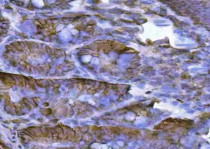ARG43902
anti-EpCAM antibody
anti-EpCAM antibody for ELISA,Flow cytometry,IHC-Formalin-fixed paraffin-embedded sections,Western blot and Mouse,Rat
Overview
| Product Description | Rabbit Polyclonal antibody recognizes EpCAM |
|---|---|
| Tested Reactivity | Ms, Rat |
| Tested Application | ELISA, FACS, IHC-P, WB |
| Host | Rabbit |
| Clonality | Polyclonal |
| Isotype | IgG |
| Target Name | EpCAM |
| Antigen Species | Mouse |
| Immunogen | Mouse EpCAM recombinant protein |
| Expression System | E.coli |
| Conjugation | Un-conjugated |
| Protein Full Name | Epithelial cell adhesion molecule |
| Alternate Names | MIC18; EGP; Tumor-associated calcium signal transducer 1; Epithelial glycoprotein 314; KSA; Ep-CAM; Epithelial cell surface antigen; Adenocarcinoma-associated antigen; HNPCC8; Cell surface glycoprotein Trop-1; EGP40; TACSTD1; KS1/4; hEGP314; Major gastrointestinal tumor-associated protein GA733-2; M4S1; MK-1; Epithelial glycoprotein; KS 1/4 antigen; ESA; DIAR5; EGP314; Epithelial cell adhesion molecule; EGP-2; TROP1; CD antigen CD326 |
Application Instructions
| Application Suggestion |
|
||||||||||
|---|---|---|---|---|---|---|---|---|---|---|---|
| Application Note | * The dilutions indicate recommended starting dilutions and the optimal dilutions or concentrations should be determined by the scientist. |
Properties
| Form | Liquid |
|---|---|
| Purification | Affinity purified with Immunogen. |
| Buffer | 0.9% NaCl, 0.2% Na2HPO4 and 4% Trehalose. |
| Stabilizer | 4% Trehalose |
| Concentration | 0.5 mg/ml |
| Storage Instruction | For continuous use, store undiluted antibody at 2-8°C for up to a week. For long-term storage, aliquot and store at -20°C or below. Storage in frost free freezers is not recommended. Avoid repeated freeze/thaw cycles. Suggest spin the vial prior to opening. The antibody solution should be gently mixed before use. |
| Note | For laboratory research only, not for drug, diagnostic or other use. |
Bioinformation
| Gene Symbol | EPCAM |
|---|---|
| Gene Full Name | Epithelial Cell Adhesion Molecule |
| Background | EpCAM is a carcinoma-associated antigen and is a member of a family that includes at least two type I membrane proteins. This antigen is expressed on most normal epithelial cells and gastrointestinal carcinomas and functions as a homotypic calcium-independent cell adhesion molecule. The antigen is being used as a target for immunotherapy treatment of human carcinomas. Mutations in this gene result in congenital tufting enteropathy. |
| Function | EpCAM may act as a physical homophilic interaction molecule between intestinal epithelial cells (IECs) and intraepithelial lymphocytes (IELs) at the mucosal epithelium for providing immunological barrier as a first line of defense against mucosal infection. Plays a role in embryonic stem cells proliferation and differentiation. Up-regulates the expression of FABP5, MYC and cyclins A and E. [UniProt] |
| Cellular Localization | Cell junction, Cell membrane, Membrane, Tight junction |
| Calculated MW | 35 kDa |
| PTM | Hyperglycosylated in carcinoma tissue as compared with autologous normal epithelia. Glycosylation at Asn-198 is crucial for protein stability. [UniProt] |
Images (4) Click the Picture to Zoom In
-
ARG43902 anti-EpCAM antibody IHC-P image
Immunohistochemistry: Mouse colon stained with ARG43902 anti-EpCAM antibody antibody at 2 μg/ml dilution.
-
ARG43902 anti-EpCAM antibody WB image
Western blot: Mouse small intestine tissue lysates withARG43902 anti-EpCAM antibody at 0.5 μg/mL dilution.
-
ARG43902 anti-EpCAM antibody FACS image
Flow Cytometry: RAW264.7 cells stained withARG43902 anti-EpCAM antibody (blue) at 1 μg/1x10^6 cells dilution.
-
ARG43902 anti-EpCAM antibody IHC-P image
Immunohistochemistry: Rat colon stained with ARG43902 anti-EpCAM antibody antibody at 2 μg/ml dilution.









